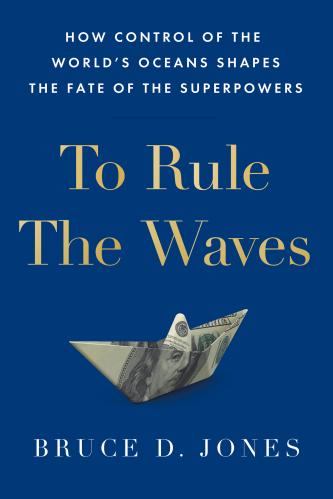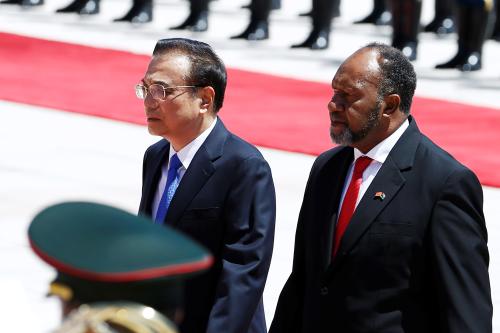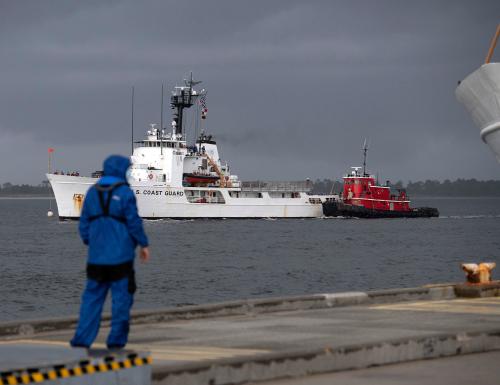On October 23, 2020, National Security Advisor Robert O’Brien announced that the U.S. Coast Guard would begin a study on the viability of deploying “enhanced” Fast Response Cutters (FRCs) to American Samoa to help address China’s increasingly malign maritime activities in the Pacific. Leaving aside for now what “enhanced” means (enhancing the existing FRC platform? Or will the FRCs be enhanced as compared to what they’re replacing, the venerable 110-foot Island Class Patrol Boat?), it’s a novelty in and of itself that the national security advisor would make such a public statement on the inner workings of a U.S. armed force and military service. Such a statement indicates the Trump administration’s continued concern about China in general, and specifically its regional maritime aspirations. Indeed, a Biden administration might be concerned about it too.
If this study results in the actual further deployment of FRCs and perhaps additional, even more capable Coast Guard cutters to the Pacific, it may mean we’re embarking on an era where we need increased cooperation and interoperability between the United States Naval Services — the Navy, Marine Corps, and Coast Guard — to address the maritime challenges posed by China across the entire competition continuum.
The United States is a Pacific nation with enduring interests and multiple partners and treaty allies in the region. In recent years, China has built extensive Anti-Access/Area-Denial (A2AD) capabilities in the Western Pacific, especially in the South China Sea, which threaten freedom of navigation and the security of U.S. allies and partners. The Naval Services can leverage long-standing traditional partnerships and presence in the region to counter these A2AD capabilities, offer reassurance to our allies, and demonstrate American resolve and commitment. Both the Navy and Marine Corps are currently implementing measures, reorganizing units, and introducing new capabilities to do just that; but the Coast Guard can also play a critical role. It brings complementary capabilities and authorities that would enhance the other Naval Services’ ability to demonstrate credible deterrence against China in the Western Pacific.
Coast Guard forces deployed with the Marines
The Marines’ recently published Commandant’s Planning Guidance (CPG) has refocused the Marine Corps on distributed expeditionary operations tailored for forward presence. These distributed expeditionary operations will also demonstrate credible deterrence to U.S. adversaries around the world, including in the Western Pacific. The Marines are in the process of establishing Marine Littoral Regiments (MLRs) that will operate forward in the Western Pacific — inside China’s A2AD bubble. These MLRs are designed to be the “stand-in force,” a term Art Corbett defines in the Marine Corps Gazette as forces that “persist and operate forward within an adversary’s weapons engagement zone.” They operate as small, distributed units across large distances and armed with lethal, long-range, anti-ship missiles that enable sea control and could counter any A2AD threat posed by China. The CPG says: “Marines will focus on exploiting positional advantage and defending key maritime terrain that enables persistent sea control and denial operations forward.”
The Coast Guard’s profile and mission make it an ideal maritime security partner for distributed MLR units in the Western Pacific, because it provides important additional options to the Naval and Joint Force Commanders to make forward presence more credible. Specifically, the Coast Guard’s broad suite of operational authorities — including to partner with other countries on maritime law enforcement and security issues, which it has employed effectively in counter-narcotics arenas throughout the Caribbean and Eastern Pacific — would provide two key attributes in the Western Pacific. First, the Coast Guard can establish force-multiplying relationships with allied and partner nations in the Western Pacific to better address China’s malign maritime activities throughout the region in the day-to-day operating conditions best described as “competition.” Strengthening and leveraging these relationships may help deter future conflict, because we’d be strengthening the abilities of China’s neighbors to better check aggressive Chinese activities. Second, it would also allow help MLR units identify, interrogate, and counter China’s so-called maritime militias, which do double-duty as fishing fleets.
For example, imagine a scenario where China and one of its neighbors have had armed skirmishes for weeks over exclusive economic zone (EEZ) and maritime border disputes. The Coast Guard has a bilateral agreement with the neighbor that allows for joint security, law enforcement operations, and EEZ enforcement. Now let’s say that MLR units are deployed to the neighbor’s offshore island territory to provide land-based, anti-ship missile cover for U.S. Navy vessels operating in the vicinity, when a Chinese “fishing fleet” shows up just offshore. Here, Coast Guard assets like an FRC or a long range, over-the-horizon small boat unit with embarked boarding teams embedded with the MLR could provide flexible options to identify, interrogate, and address the challenge, compared to if the MLR were to try to figure out how to handle the fishing fleet on its own. There is, after all, that old saying about trying to solve problems when you only have a hammer.
If Coast Guard forces integrate with MLRs, operational commanders get a whole new toolbox. And here, the intent would be to give the Chinese vessels an off-ramp to de-escalate the situation and withdraw, by using the Coast Guard — in partnership with the neighbor as part of the bilateral agreement — to help enforce the neighbor’s territorial sovereignty through communications, visits, and boardings. If the off-ramp isn’t used, then the Coast Guard or MLR units can use escalatory measures as appropriate, such as armed, unmanned aviation systems and surface vessels.
The Marines deployed with Coast Guard forces
Further, Coast Guard cutters — especially the larger National Security Cutters and importantly the coming Offshore Patrol Cutters — would provide excellent, cost-effective, force-multiplying platforms to advance the Marine Corps’ goals. These cutters complement the Corps’ current plans centered on the Expeditionary Advanced Base Operations concept, which makes use of the equally novel Light Amphibious Warfare concept. Indeed, as Coast Guard Lieutenant Commander Daniel Wiltshire notes, even the FRCs Ambassador O’Brien referenced could have utility in joint operations by embedding Marines at, say, the squad level.
Here’s why: Employing Marine Corps units in various configurations aboard Coast Guard cutters in the Pacific theater would create a tactical dilemma for China. Specifically, such a move could further frustrate targeting by China’s navy, as well as increase the risks for China’s Coast Guard if it attempts more aggressive interactions short of actual armed conflict. Put another way, the Marines get more platforms by which to distribute their lighter but harder-hitting, forward-sensing forces; and the Coast Guard gets ready access to a lethality boost, should such a boost ever be needed.
What’s next?
Several preliminary steps are needed to occur to improve interoperability. First, the United States Sea Services should finalize the pending tri-service maritime strategy update. Issuing this joint doctrine — which will focus on the interconnected attributes of the Navy, Marine Corps, and Coast Guard — will send an important message that maritime interoperability is a fundamental and foundational requirement to address 21st-century challenges, and should it come to it, threats.
Second, all three services should actively develop, establish, and advance a culture of interoperability and mutual respect. This means enhancing familiarity with each other’s operations, capabilities, and authorities through increased use (wherever possible) of joint assignments and details, standardized training and human performance improvement, acquisitions, and collaborative development of policy and doctrine. Additionally, discussions about future fleet makeups must account for the needs and capabilities provided by all three services, which is something that has, to date, been largely lacking — specifically with respect to how the Coast Guard fits into the push for a future fleet with 355 (now 500?!) ships.
Relatedly, all three Sea Services will have to appropriately prioritize what will likely be diminishing defense budgets in the years to come. The Marine Corps has already started, through significant cuts in its heavy armor capability and infantry capacity. For the Coast Guard, this will likely mean a renewed focus on its defense readiness mission, the likes of which haven’t been seen since World War II. The result could be a much “toothier” Coast Guard, even compared to what rose from the ashes of the terror attacks on September 11, 2001. With this renewed focus should come a prioritization of unmanned aviation and surface systems, sensors, and communications technology so that Coast Guard units can securely and ideally seamlessly fold into the broader defense enterprise. That may likewise require the Coast Guard to take a truly hard look at where it, like the Marines, can cut legacy programs and capabilities that are not geared towards today’s mission priorities — something that to date, the Coast Guard has been relatively resistant to do.
The views expressed are the authors’ alone and do not reflect the official policy or position of the United States Coast Guard, U.S. Marine Corps, U.S. Department of Defense, U.S. Department of Homeland Security, or the U.S. Government.










Commentary
The Coast Guard and Marines should work together to enhance deterrence in the Western Pacific
November 12, 2020